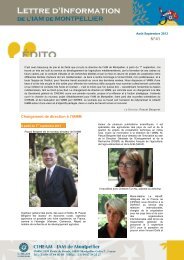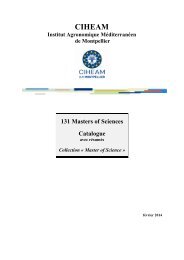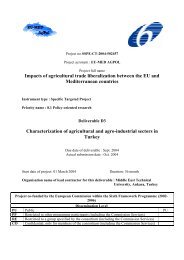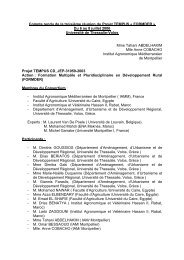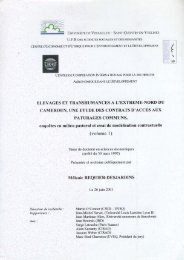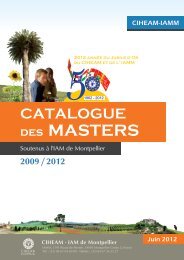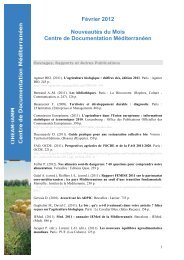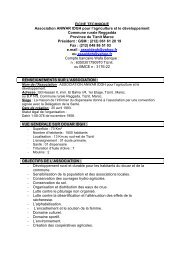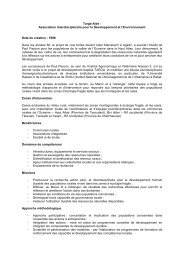Evolution of Mediterranean Diet: Facts, Causes, Effects
Evolution of Mediterranean Diet: Facts, Causes, Effects
Evolution of Mediterranean Diet: Facts, Causes, Effects
You also want an ePaper? Increase the reach of your titles
YUMPU automatically turns print PDFs into web optimized ePapers that Google loves.
<strong>Evolution</strong> <strong>of</strong> <strong>Mediterranean</strong> <strong>Diet</strong>: <strong>Facts</strong>, <strong>Causes</strong>, <strong>Effects</strong>M. PadillaCMEAMAAM Montpellier, F-34093 Montpellier Cedex 3, FranceWe will first go back several centuries in order to understand the historical characteristics<strong>of</strong> <strong>Mediterranean</strong> food availabiiities. We will then consider the diversity <strong>of</strong> <strong>Mediterranean</strong>food and finally present an overview <strong>of</strong> the recent evolutions.1- <strong>Facts</strong>I.1. Hktorical <strong>Evolution</strong>We can characterise five main historical periods which have influenced <strong>Mediterranean</strong>food :Years BCTrading traffics and great civilisations, which mixed a lot <strong>of</strong> people, have allowed thespreading <strong>of</strong> <strong>Mediterranean</strong> food products: Mesopotamian, Aegean, Phoenicians and later,Carthaginians have exported olive trees, vine, fig trees and almond trees, they have brought tothe West (Rome) pepper and spices from Asia (India). These diverse colonisations have alsointroduced wheat, barley, oats, ciaus fruits, sheep, goats and oxen in the <strong>Mediterranean</strong>countries.RomansThey have deeply modified production bases by colonisation: every conquered tenitory hadto cultivate vine and olive trees. This way, Romans marked the limits <strong>of</strong> their power. Theyimposed wheat in Turkey, Egypt, Greece, Sicily, Andalusia and Languedoc; they spreadgarden peas, beans, lentils, chickpea and green vegetables, al1 <strong>of</strong> them issued from Easternareas <strong>of</strong> the Roman Empire.The last food conquests from tbe eastern worldArabians spread ciaus fruits dl around the <strong>Mediterranean</strong> area. Byzantines and especiallyOttomans had a significant influence on food practices in the 1 2 and ~ 13" century. Crusadesbrought rice and cane sugar. The discovery <strong>of</strong> China in 1298 has allowed the consumption <strong>of</strong>pasta and vegetables from the gourd family (like cucumber and marrow).It is sometimes said that <strong>Mediterranean</strong> diet has been formed during two essential periods:Classical Antiquity and Arabian Empire. During the Classical Antiquity, the internationaltrade was developed. This allowed the Roman Empire to strongly modify dietary habits.Conversely, Arabians protected diversity and spread agronomic and technical knowledge.Cities were in symbiosis with their couniries. These practices contributed to the development<strong>of</strong> regional cooking.Discovery <strong>of</strong> the AmericasDuring the new wave, some products, which were introduced via Spain and Portugal,became staple food in the <strong>Mediterranean</strong> ara, such as corn, potatoes, tomatoes, sweetpeppers, gourd and chocolate and finally, the last colonisation ( 19~ and 2oLh century) hasbrought tender wheat, lentils, corn, tomatoes, salad, artichokes, asparagus, chestnuts andacorns into the Maghreb
NEAR EASTand MlMKE EASTw w 9Figure 1. Origm <strong>of</strong> <strong>Mediterranean</strong> productsin figure 1, we can see the principal borrowings by the <strong>Mediterranean</strong> from other regions<strong>of</strong> the world. There is no food nowadays which can be considered typical regional in a strictsense.1.2. Regional characteristicsEven if the major changes in staple production has been achieved, we wonder how a single<strong>Mediterranean</strong> food model could be bom out <strong>of</strong> the diversity <strong>of</strong> people, cultures and foodacquisition disparities in this area. From the middle <strong>of</strong> the 19" century, the major economicchanges, characterised by a standardisation <strong>of</strong> food practices on a national and intemationalscale, with the development <strong>of</strong> intemational vast agricultural markets, and the increasingmobility <strong>of</strong> the populations, could have lead to a uniformity <strong>of</strong> food habits among nations.Mter analysis we found that different food models between the North and the South<strong>Mediterranean</strong> counmes are still observed, and also between the different counmesencompassing the referent model, which made up the European <strong>Mediterranean</strong> countries(Figure 2).Contrast in food intake structure between northem and southern <strong>Mediterranean</strong> countrieswas and remains still strong (Figure 3). in the South, food intake is above al1 vegetal (lessthan 10 % <strong>of</strong> the total calorie intake is <strong>of</strong> animal origin because <strong>of</strong> lacking availabilities andhigh prices) and made up <strong>of</strong> carbohydrates (65-70 % <strong>of</strong> the total calorie intake). Cereals,together with pulses, are the basis <strong>of</strong> food. The gap conceming the part <strong>of</strong> animal products inthe food intake between the North and the South is increasing. We are attending a real fooddrift in the <strong>Mediterranean</strong> countries; the South remains very traditional in spite <strong>of</strong> adoption <strong>of</strong>modemity in their food practices in urban areas. The North looses its identity and the image<strong>of</strong> health diet that it generated.
CerealsSugarFruits' vegetablesFatsIiIVieat, eygçFishFigure 2. Cornparison <strong>of</strong> north and south-mediterranean diets relatively to occidental diet in1995 (Source : FAOIAGROSTAT)Figure 3. Food availabilities (Kgkaplyear) 1996 (Source : FAOIAGROSTAT)
In the Northem <strong>Mediterranean</strong> area, some regional differences still appear. Spain andPortugal are characterised by a greater consumption <strong>of</strong> potatoes, fish and seafood; Italy differsby cereals and dairies. In Greece more cereals, vegetables, fruits and intemationally wellknown« feta » is consumed than in other countries. It is not surprising that France is above al!the most « westernised~ <strong>Mediterranean</strong> country, with a great relative consumption <strong>of</strong> mearand rnilk. Pulses, sugar, oils and fats are uniformly distributed, Portugal and France aredistinguishable from other countries by a high consumption <strong>of</strong> alcoholic beverages, mainlywine. Analysis at local level should be done for more precise regional differentiation <strong>of</strong>products and cooking. Cooking is an illustration <strong>of</strong> history <strong>of</strong> populations and does not respectgeographical frontiers: Greeks are highly influenced by oriental and Ottoman's cooking,Spain, and also Sicily, by Moorish, and Provence (Southem France) by Italian cooking.I.3 Recenr evoluîionsThis healthy mode1 took serveral cnturies to develope and still had just an phemeral life; itis currently undergoing a pr<strong>of</strong>ound change. Globally we are moving towards over-eating andboth food and nutritional balances are broken. An increase <strong>of</strong> quatities cosumed is observed,up to a level which must be judged as immoderate.The average energy intake in the nineties amounted to 3450 kcaiicapitdday, whereas in thesixties it was 2900 kcalCerealsSugar 150200 IFruits, vegetablesFatsPulses~eat; eggsFigure 4. <strong>Evolution</strong> <strong>of</strong> <strong>Mediterranean</strong> diet versus western diet 1 1960 - 1995(Source : FAO/AGROSTAT)We can observe an immoderate consumption <strong>of</strong> animal products with 30% <strong>of</strong> the totalcalorie intake in 1995, whereas it amounted to 23% in the sixties.The proportion <strong>of</strong> added fats inîake has also strongly increased: from 25% in 1%3, tonearly 40 %, 30 years later.
Nature <strong>of</strong> consumed iipids has changed, especially in Portugal, Spain and Italy, where theincrease <strong>of</strong> animal fats is high. In France and Greece, however, the increase <strong>of</strong> vegetable fat ishighe:. glucidr.C..-.>M- Greece ' 1protida 1Figure 5. Evolu tion <strong>of</strong> the nutritional structure <strong>of</strong> diet (1 963 and 1996)(Source FAOJAGROSTAT)II - <strong>Causes</strong>Socio-economists explain this development by a change <strong>of</strong> the consumer's social andeconomic environment. 1 have selected three <strong>of</strong> the main reasons.ILI Constitution <strong>of</strong> Europe and broadened marketsReasons <strong>of</strong> this development can be explained by a phenomenon <strong>of</strong> imitation <strong>of</strong>economically important countries such as Northem Europe and The United States.Transformation <strong>of</strong> way <strong>of</strong> iife and their corollaries - disruption <strong>of</strong> food patterns andindustrialisation <strong>of</strong> consumption - appeared with the constitution <strong>of</strong> the European Community.The first signs were observed in 1975, with the beginning <strong>of</strong> a probation <strong>of</strong> the <strong>Mediterranean</strong>countries candidates to adhesion to E.E.C Spain, Greece, Portugal. European harmonisationand necessity <strong>of</strong> applicant countries to integrate into the European organisation system had animportant repercussion in the society: multiple contacts between countries, more and moremigrations and exchanges <strong>of</strong> population, competitiveness, implantation <strong>of</strong> Northern agro-foodindustries and distribution lines, al1 factors favounng the implementation <strong>of</strong> a Northernconsumption model. Besides, there was a change from
~p11.2 Food representationsTable 1. Food representation steps in occidental countries, . *+TV-After 1992Decrease <strong>of</strong>condemnedproductsChasing calories.Sugar, fatThinnessfrom foodNew practicesFrozen food,Ready-madeproductsdisruption . <strong>of</strong>meals structuresocial issuewithout)Traditional disheslifeChoice aniongproductsExplorationRehabiliiationIndividualbiologicalrhythmLessMinimalismErsatzQuality, TasteTO EAT LESSTO EATQUICKLYTO EATW ITHOUTï0 EAT WELLSource: A Defrance (2)We can characterise five main periods after the second world war (Table 1) According tothe symbol attached to an « ideal >> society (safety, thinness, social issue, balance...), thestrong recommendation in the food field (eat more, eat less, eat quickly, eat without, eatwell) will have repercussions on expectations <strong>of</strong> consumers and food products from industrialinnovation.11.3 Socio-economic mutations <strong>of</strong> society contributed to the evolution <strong>of</strong> the representationsChanges <strong>of</strong> lifestyles are detectable at six levels:De-cohabitation <strong>of</strong> the members <strong>of</strong> households: The size <strong>of</strong> the households is rapidlydecreasing and single-households are not anymore rare (10 to 30% <strong>of</strong> households). Decohabitationfavours consumption <strong>of</strong> ready-to-eat food and served food.Pr<strong>of</strong>essional life is attracting more and more women: 30 to 40% <strong>of</strong> women are nowworking out <strong>of</strong> home (Figure 6). Time constraints become as strong as income constraintsto explain consumption choices.
4035 - - SpainIFranceAmGreecea' Italy105 6 PortugalO. I II 11960's 1970's 1980's 1990'sFigure 6. <strong>Evolution</strong> <strong>of</strong> employed women in the total <strong>of</strong> women - 196011990Organisation <strong>of</strong> work: Generalisation <strong>of</strong> working al1 day induces improvement <strong>of</strong>catering industry and fast food. This situation favours an Anglo-saxon dietary modelrather than a <strong>Mediterranean</strong> model.<strong>Evolution</strong> <strong>of</strong> consumption sequences: Conception <strong>of</strong> three daily meals disappears andthe number <strong>of</strong> food intake in a day increases. From another source, moreover, the changefrom kitchen to « laboratory » has changed conviviality <strong>of</strong> the evening meal. In Spain,e.g.. dinner is <strong>of</strong>ten fast food, eaten in the living room while watching television.Historical and cultural components. For example, the Spanish were still living understarvation and had an isolated regime fifty years ago. As a reaction, there was an excessivedesire for affluence to privilege quantity as opposed to quality and rejecting foodsreminding <strong>of</strong> the poor period, such as bread, potatoes, cd, <strong>of</strong>fal and legumes.More and more, collective environment substitutes family groups. Tastes <strong>of</strong> youngpeople are developed essentially out <strong>of</strong> the family by means <strong>of</strong> symbolisation <strong>of</strong> powers.Food, just like language, is an element to protest, to agree, to take revenge, to get power ata group level(3).III- <strong>Effects</strong>III.1 International spreading <strong>of</strong> <strong>Mediterranean</strong> dietThe European Union that perverted the <strong>Mediterranean</strong> model might now rehabilitate it. Itmight do large-scale promotion for it, due to the phenomenon <strong>of</strong> spreading-imitation. In fact.on the spur <strong>of</strong> medical pr<strong>of</strong>ession, Anglo-saxon countries are developing informationcampaigns, giving the <strong>Mediterranean</strong> model as exemplary. Americans, English andAustralians have put the « <strong>Mediterranean</strong> <strong>Diet</strong> Pyramid » in their <strong>of</strong>ficia1 foodrecommendations. This model aims to increase consumption <strong>of</strong> specific foodstuffs and toencourage ethnic and food diversity. Recommendations are based on a diet <strong>of</strong> the sixtiesprevailing in Crete and South Italy. The <strong>Mediterranean</strong> pyramid does not constitute the solerecommendation at the world level. Indeed, Latino-American, Asian, Vegetarian and the onearising from USDA (4) are also sources <strong>of</strong> recommendation, but only the <strong>Mediterranean</strong> isapproved by the World Health Organisation.
Paradoxically, it is in the North that the <strong>Mediterranean</strong> model makes up for lost ground. Itlooks like <strong>Mediterranean</strong> food is on its way to become a real phenomenon <strong>of</strong> society. Anumber <strong>of</strong> big agro-food companies use the <strong>Mediterranean</strong> image in their marketingpromotion, even the leader <strong>of</strong> food uniformity, McDonalds.111.2 Re-appropriation <strong>of</strong> the <strong>Mediterranean</strong> diei under modern fomtsWe carried out a pilot European study CO-ordinated by M. Gerber and myself in France,Italy, Spain, England and Belgium in 1998. The aim <strong>of</strong> this study was to analysecharacteristics <strong>of</strong> the <strong>Mediterranean</strong> food and its impact on Northem populations. This studyhas verified that <strong>Mediterranean</strong> diet is persisting. It has even been re-appropnated byconsumers with adaptations to their new iifestyle and expectations.in the <strong>Mediterranean</strong> ara, contrary to the current Western habits, women usually prepare awarm meal every day. in addition, the young generation adapt mother's recipes bysimpiifying the mals and by integrating less fat, less meat and less sugar. They diversify theirfood repertory by integrating news dishes (couscous, tajine), <strong>of</strong>ten from the <strong>Mediterranean</strong>area. Implications in food are strong. Knowledge is <strong>of</strong>ten transrnitted between generations andin particular between mothers and daughters. In France, 41 % <strong>of</strong> food specialities have beentransmitted this way, and only 20 % by cooking books.ConclusionThe use <strong>of</strong> <strong>Mediterranean</strong> image in marketing suggests that we can find the stake thatmobilises consumers, and use it to extend the model. The more this stake requests « stronglyincentive approaches », the more its use in marketing has chances to be performed.This stake is distributed along four identity-related axes, which give their power to thepromises possibly carried by <strong>Mediterranean</strong> diet.Combination <strong>of</strong> pleasure and health: renewal with nourishing food, taking distance to"hygienist" American food culture, valorising sensorial aspects, making a dichotomybetween the good and the bad.Emphasising European culture, with its diversified tastes and colours as a base for<strong>Mediterranean</strong> identity: After integration and mixture <strong>of</strong> different culinarycontributions, the <strong>Mediterranean</strong> cuiinary identity is now becorning a reference that isexported everywhere.Mobilising a desire <strong>of</strong> rebirth and « re-assurance » by a return to the sources: Thistrend is explainable by the rupture between production iine and consumption chain. Thisrupture creates an anxiety on the consumer who can no more clearly identify his food. Itinvolves request for regional and authentic food products, traditional recipes and naturalfood products.The consumer is more concerned about health, food security and nutritional balance:Consumers are also more attentive to environment problems, conditions <strong>of</strong> production,food products development and companies which are « politically correct ». A newmedical reading has contributed to a revival <strong>of</strong> <strong>Mediterranean</strong> food, and allowsrecognition through the eiite <strong>of</strong> ancestral and popular knowledge about the <strong>Mediterranean</strong>diet.
References(1) Cresta M. and Teti V. The road <strong>of</strong> foods habits in the <strong>Mediterranean</strong> area betweenbiology and culture.(2) Defrance A. (1994). "To eat or not to eat, 25 ans de discours alimentaire dans la presse".Les Cahiers de I'OCHA, n04, CIDIL, Paris.(3) Fidanza A. (1990). <strong>Mediterranean</strong> Meal Patterns. in: Nuiritional adptation to new lijésoles,(Somogyi JC, Koskinen EH. eds)., N045, pp 59-71. Bibl Nutr <strong>Diet</strong>a. Basel,Karger.(4) Barone J. (1998). Up and down the food pyramids.(5) http://onhealthnetworkcompany.com.Further readingBarrau J (1983). Les hommes et leurs aliments, Temps Actuels, , 378p.Grivetti L (1997). Morning meals. North American and <strong>Mediterranean</strong> Breakfastpatterns. Part 3. <strong>Mediterranean</strong> patterns and surnrnary. Nuirition today 32, N04,Julylaugust.Haber B. (1997). The mediteranean diet: a view from history. Am J Clin Nutr. 66(suppl), 1053s-7s.Harlan Jr, (1987). Les plantes cultivées et l'homme, ACCT, ,410~.Malassis L,. Padilla M. (1986). Traite d'économie agro-alimentaire - Tome IiI :« 1'Cconomie mondiale ». Editions Cujas, 449 p.Malassis L, (1994). Noumr les hommes, Ed. Flammarion, Collection Dominos, 126p.Padilla M. (1996). Trait6 d'économie agro-alimentaire, Tome IV : "Les politiquesalimentaires". Editions Cujas, 255 p.Padilia M. and Le Bihan G., (1997). « La dynamique internationale de la consommationalimentaire ». in : Economies et sociétés, SCrie AG n023, , p.11-25.Padilia M., Allaya M., Malassis L, (1997). «Que mangeons-nous?», AgropolisMuseum /Ciheam-Iam, Montpellier.Padilla M., Gerber M. (Coord) (1998). «Consommer mCditerranCen, une attitudeprCventive au cancer B. Rapport$nalprojet européen, Commission EuropCenne, DG V.Trichopoulou A, Lagiou P (1997) Healthy traditional mediterranean diet: an expression<strong>of</strong> culture, history and filfe-style. Nutrition Reviews 55,383-389.Volatier JL (1999). Le repas traditionnel se porte encore bien, CREDOC consommationet modes de vie. N0132.



